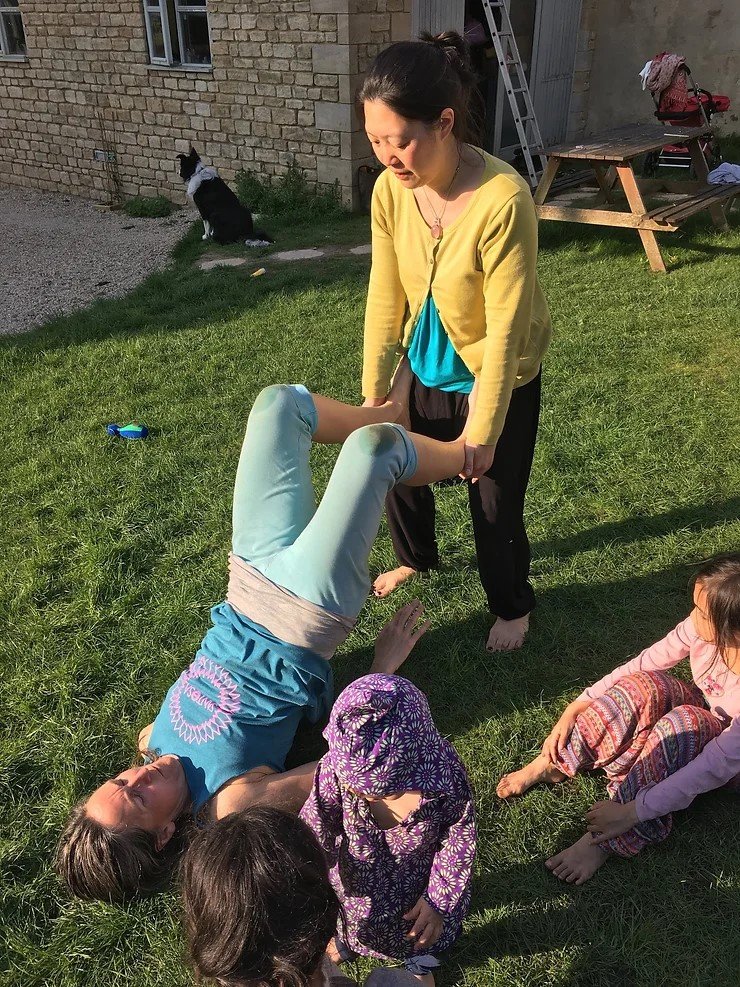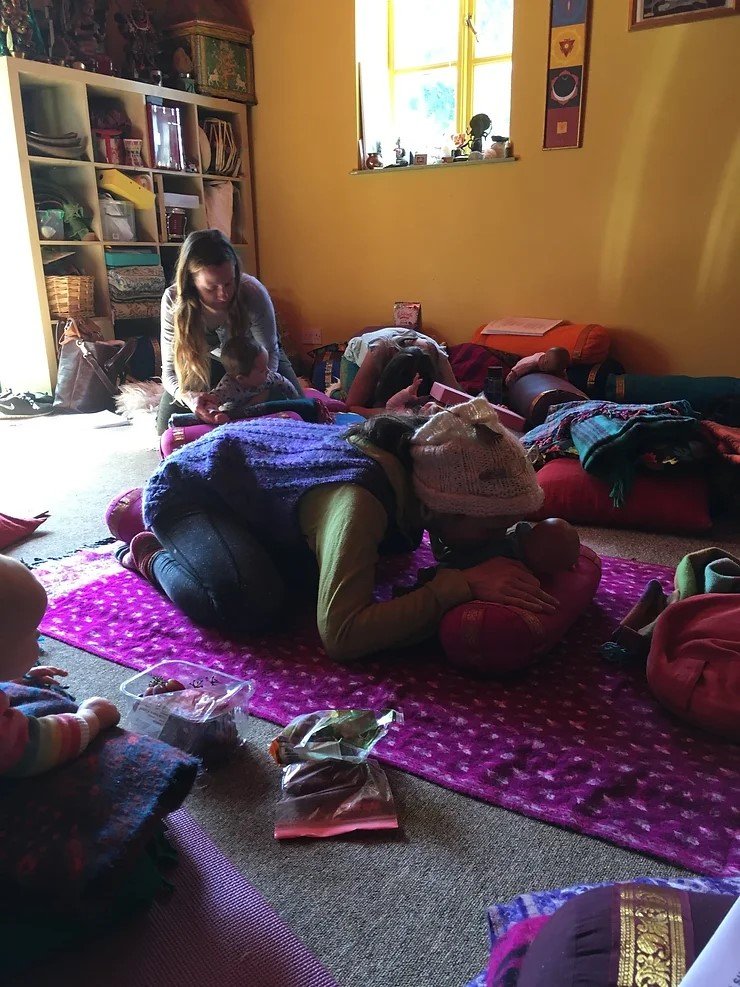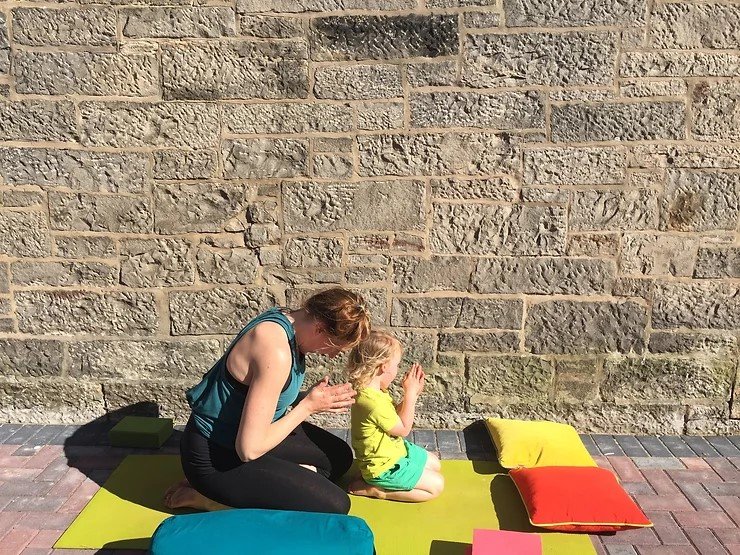Benefits of family yoga
“Movement is a powerful tool. We can transform our bodies, families, communities, and the planet… simply by moving more.”
Katy Bowman
As a mother of two gorgeous babas I am understanding the value of Yoga not just for my own self care and wellbeing but the profound impact for my family dynamic. I feel so strongly about the hugely positive benefits of family yoga, that I am starting a family yoga class with a gorgeous friend, mama and fellow yogi Sonja. An opportunity for us to share and explore together with other families, build community, support and promote the value of self care, inquiry and love for ourselves and our families.
As part of the integrated training in family yoga, mum and baby and post natal yoga, with the wonderful Uma Dinsmore and Janice Wong, I was asked to reseach and explore how yoga could be of assistance to young families. So here are my humble musings and personal experience.
How Family Yoga has benefitted me
When thinking about this question I was reminded of a really crystal-clear moment I had as a young mother. One which I went on to write about on my blog ‘babies are the best yoga teachers’.
Watching my baby from the day he was born, I was mesmerised by how effortlessly present and adaptable babies are.
As a yoga enthusiast I had always struggled with the things that babies just did organically. It had been a hugely profound experience for me, as I had worried that having a baby would impact negatively on my yoga practice; I wouldn’t have the luxury of practicing when I wished, going to class, travelling for training etc. So I was astounded when the opposite happened. Having my baby opened my eyes, my heart and my being to all the details, all the parts I had been quick to brush over on route to something bigger. I had missed the essence, the simplicity and the subtleties of even the smallest gesture, movement, breath or moment.
I kept coming back to these realisations and how Yoga became part of my day to day as a result of having my baby. I think these also apply to how Yoga can be so beneficial in family life;
Having a baby is a perfect lesson in the art of living in the present moment.
Prioritising Rest – Learning about self-care and self-love
Breathing Patience – Slowing down and noticing the detail.
Finding a Daily Practice of Self care – How yoga helped me navigate my ever-changing emotions, physicality and thought processes as I transitioned into Motherhood.
In a world where people are increasingly over stretched, stressed and often overwhelmed, in western culture where family and children are not a priority of society and where most modern-day families are not surrounded by extended family or community for support, there is, I feel an ever-increasing need for Yoga. As Deborah Jackson discusses in her book ‘three in a bed’, we are not supposed to raise our children alone. As the well known African proverb says ‘it takes a village to raise a child’. Yet there is tremendous pressure on parents to be seen to be coping, to be the balanced, self-sufficient, independent and able to juggle, work, family life, healthy living, social lives etc. Yoga with its diverse array of techniques for calming, strengthening and harmonising mind, body and spirit, can support and help families to be active together, conscious and mindful of their own needs while consciously respecting others and our environment.
So what is the value of Yoga for families?
Family Yoga can encourage a sense of playfulness, fun and creativity in interactions between parents and their children to help enrich communication, support closeness and personal connection and enhance everyone’s development in a nurturing way.
1. SELF AWARENESS & MUTUAL RESPECT
Babies and children are already embodying and practicing the principles of yoga in their everyday, both present and awakened to their experiences, their senses and their bodies. As parents we can learn from them. Family yoga can help to cultivate open minded acceptance in a parent child relationship. The impact of a family sharing time together to be exactly as they are and to learn from each other can have a profound effect on relationships, cultivating mutual respect and deepening self awareness both of our own body and breath but equally important, of our relationship with our environment our responsibility to, and impact on it.
IN ACTION: Honouring where our body is, recognising and checking in with our breath and our body as we move through asanas together, and on our own. Sensitising to our environment and its relative impact upon us.
I did pranayama each day when my son was feeding or sleeping, watching him, his breath and the rhythm of his belly was incredibly relaxing and reminded me to explore the fullness of my own breath. Amidst the chaos of extended sleep deprivation and a feeling my parents will relate, that very little is within your control, having a daily routine of even a few minutes to focus on the breath was powerful beyond measure. Calming for me and deeply nourishing for my nervous system. I fully admit that this and savasana kept me from loosing my marbles.
UMA DINSMORE TULI AND JANICE WONG DEMONSTRATING FAMILY YOGA PARTNERING OPTIONS FOR SHOULDER STAND.
2. ACCESSIBILITY
Yoga is accessible and can be available to all. Yoga can be done anywhere, it requires little or no equipment and is relatively cheap to attend a class or free if done at home. In a world, where the modern family is often living independently from their extended family or a support network and time and money are often a restriction, this is an attractive option. We can definitely do much more to increase accessibility of yoga for all. In Edinburgh, I am hugely grateful for the amazing work of Laura Wilson and Edinburgh Community Yoga for this.
IN ACTION: For me, yoga was the most powerful support in early motherhood and today juggling life with two. I could do small amounts of yoga with my son in the sling, lying next to me and then as he grew, with him. I started to explore and mimic some of the movements he did in my practice. A sort of free form movement and found it was amazing for loosening and warming up the tighter parts of my body – hips etc. I also tried to start building in time to talk about the breath and using it in times of frustration or confusion or conflict. Deep breathing with the nose. Big exhales and body release and breath with sound. This was definitely integrated into family life off the mat and is something I wish to cultivate more as our family grows.
3. ACCEPTANCE
Exploring postures and movement with the approach of feeling into what works best for your body is an example of how yoga promotes self inquiry and acceptance. As a family, exploring postures and modifications relevant for each person and acknowledging the beauty of difference, of personal attributes and qualities without comparison or judgement, is a wonderful thing.
In a parent child situation there is role modelling, teaching and guidance. In this context each individual can learn from the other and just be themselves in an activity and setting where there isn’t a ‘right’ or ‘wrong’ way, just a ‘present’ way best for you and your body in that moment. This opportunity to recognise the importance of being present, compassionate and aware, in a climate where attainment, competition and comparison, be in through the education system or social media, are surely positive virtues that would be of benefit to young people and their family,
IN ACTION: As my son has gotten older we have enjoyed moving through different asanas and particularly experimenting with partnering together for certain postures. It is lovely to move into a posture together and then we discuss the shapes and how we are different in our posture but how somethings are similar or the same. And through my son’s lead we enjoy exploring our own versions of poses that organically feel good.
4. SELF DISCIPLINE & CREATIVITY
It is well documented that imaginative, experiential and creative play are of vital importance for children in early years and beyond, helping to nurture a Childs natural laws of growth and unfoldment. As M Donaldson states in her book ‘Children’s Minds’ yoga can develop two very important aspects in the personality of a child; self-discipline and stimulating creativity. Never more so have we needed to nurture these attributes in our children, in a society where self-adaptability, regulation and divergent thinking are needed to navigate a world of heightened sensory stimulation, where jobs, vocations and careers are now multi-faceted and constantly evolving. Where media and technology are developing faster than our understanding of the relative implications of its use on, the human brain, emotional, physical and mental wellbeing. In essence, our need to recognise the merits and use of technology must be underpinned by a deep respect and active relationship with our environment, with mother nature and a recognition of our responsibility for both the environment and ourselves.
IN ACTION: After the birth of our first son we begin practicing yoga together as a family, actively seeking opportunities both at home and in nature to move, breath, explore and play. The impact for me personally and on my now 4-year-old son has both astounded and inspired me. After the recent birth of my second son, family yoga has been an active part of our day to day lives. I continue to be mesmerised by the scope and opportunity yoga offers me as a mother and a woman. Often, we do yoga outdoors, naturally becoming more sensitised to our breath, drawing a deeper breath and never more so did I recognise the impact of this on the nervous system than in my son. He is calmer, happier and more acutely responsive in nature. The beauty, as I mentioned above is you can do yoga ANYWHERE! Yoga is so much more than making shapes with our bodies and the more subtle practices of pranayama, sonic massage, mudras, meditation and story telling can be done in all manner of contexts… Aka I have used it when; camping, in the car, in the bath, waiting for the bus, stuck in a que… (I feel a future blog post sharing these gems may be in store :).
5. RELAXATION
Celebrating and prioritising relaxation and cultivating a deeper sense of inner connection. The importance of practicing Shavasana at the end of each yoga session to promote relaxation, to calm the mind, is what some believe to be one of the most important aspects of the practice. As it provides an opportunity for our body to really integrate what its learned, to observe the breath and how we feel. the use of sound vibration, breathwork, body scanning and other relaxation techniques have been proven to have a profound and deep impact on the nervous system, helping to promote more restful sleep, vitality in the body, reduce stress and calm the mind. Again its a no brainer in my mind. Every human needs this and for sure parents, babies, children and young adults. Recognising the importance of, and practical ways to ensure self care, is a valuable skill set for life’s technicoloured experiences, highs, lows, set backs, achievements and all that's in-between.
IN ACTION: This is something I have done with my son since he was little, I used to lie with him next to me in shavasana, or on my chest. I have always loved this moment, feeling each other’s breath, breathing together, there is a deep connection and it also reminds me of when he was in my womb. When we attended the family yoga he chose to lie on his own mat and I was astounded that he got under his own blanket and lay still, peaceful for the whole time. He also said that was his favourite part. I think creating space and time to relax together in this mindful way is really powerful. I notice the energy shift in my son after these sessions and his ability to find stillness. I am keen to explore more ways to support this through aspects of movement and pranayama.
UMA DINSMORE TULI DEMONSTRATING THE USE OF SONIC MASSAGE AND BIJA MANTRA TO PROMOTE RELAXATION.
Want to try Family yoga in Edinburgh?
Inspired? Intrigued? Curious?... Come try it for yourself. Join me, Sonja and our families for some Family yoga. Sessions are scheduled for March, May, July and September. Full listings of dates can be found on my timetable and booking options are available in the class description.
So don’t take my word for it! Give it a go!
And I will leave you with these words to ponder on from Cheryl Sanders book ‘Children play’;
‘If we see movement as learned at a deep level through the environment, we can begin to understand it as the subtle language of the soul, and distinctly different in different cultures… Movement is not just the movement of my voluntary muscles in response to my wishes. It is also my response to the world…the disruption of the sense of movement wholly disrupts our ability to live in the world with a sense of purpose.’
Tess x




